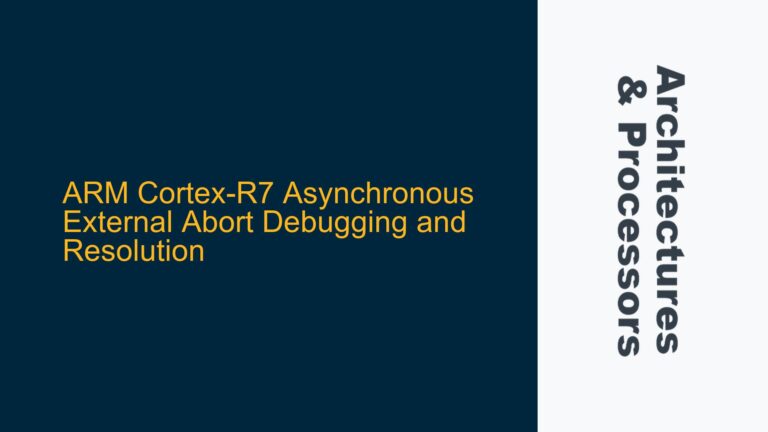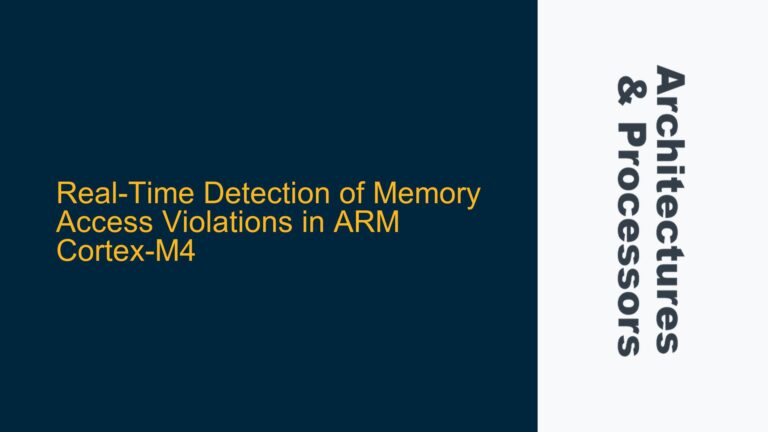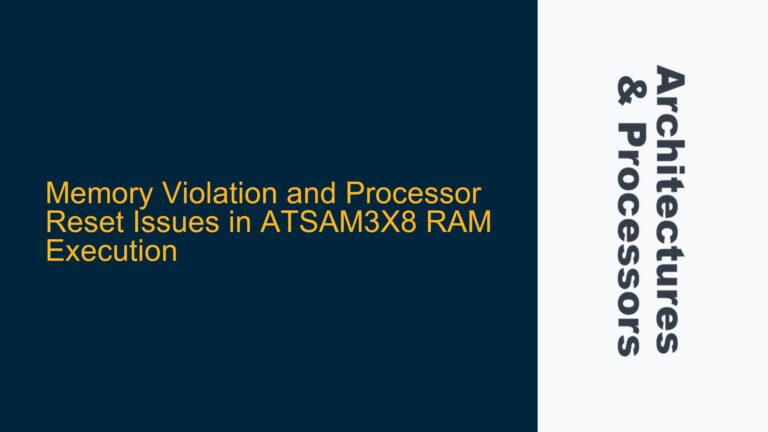Flash Memory Access Latency on ARM Cortex-M4
The ARM Cortex-M4 processor, like many embedded microcontrollers, relies heavily on flash memory for storing program code and constants. However, accessing flash memory is inherently slower than accessing SRAM due to the physical characteristics of flash technology. The Cortex-M4 core itself does not dictate the exact number of cycles required for flash access; this is determined by the specific System-on-Chip (SoC) implementation and the flash memory controller. The Cortex-M4 Technical Reference Manual (TRM) provides baseline cycle counts for instructions, but these assume zero wait states. In real-world applications, wait states are often introduced to accommodate the slower access times of flash memory.
When executing an LDR (Load Register) instruction from flash memory, the Cortex-M4 processor must wait for the data to be fetched from the flash array. This fetch operation can take multiple cycles, depending on the clock speed of the processor and the latency of the flash memory. For example, if the flash memory requires 6 cycles to deliver the data, the LDR instruction will take 6 cycles to complete, even though the Cortex-M4 TRM might list the instruction as taking only 2 cycles under ideal conditions.
The latency of flash memory access is influenced by several factors, including the clock speed of the processor, the architecture of the flash memory controller, and the presence of any prefetch or cache mechanisms. Some SoCs implement a flash accelerator or prefetch buffer to reduce the effective latency of flash accesses by fetching instructions or data in advance. However, these mechanisms are not always effective for all access patterns, particularly when accessing non-sequential data or constants stored in flash.
Impact of Processor Clock Speed on Flash Access Latency
One of the key considerations when analyzing flash memory access latency is the relationship between the processor clock speed and the flash memory access time. Flash memory has a fixed access time, which is determined by the physical characteristics of the memory cells. When the processor clock speed is increased, the number of cycles required to access the flash memory may also increase if the flash memory cannot keep up with the higher clock speed. This is because the flash memory controller may need to insert additional wait states to ensure that the data is correctly fetched from the flash array.
Conversely, reducing the processor clock speed can sometimes reduce the number of wait states required for flash access, as the flash memory may be able to deliver data within fewer cycles at a lower clock speed. However, this is not always the case, as some flash memory controllers are designed to operate at a fixed latency regardless of the processor clock speed. In such cases, reducing the clock speed will not reduce the number of cycles required for flash access, but it will reduce the overall time taken for the access due to the longer duration of each cycle.
The relationship between processor clock speed and flash access latency is highly dependent on the specific SoC implementation. Some SoCs allow the number of wait states to be configured dynamically based on the clock speed, while others require a fixed number of wait states to be set during initialization. It is important to consult the datasheet or reference manual for the specific SoC being used to determine the exact behavior of the flash memory controller and the impact of clock speed on flash access latency.
LDR Instruction Cycle Count and Address Calculation
The LDR instruction on the ARM Cortex-M4 is used to load a value from memory into a register. The cycle count for the LDR instruction can vary depending on the source of the data being loaded. When loading data from SRAM, the LDR instruction typically takes 2 cycles, as specified in the Cortex-M4 TRM. However, when loading data from flash memory, the cycle count can increase significantly due to the additional wait states required for flash access.
The Cortex-M4 TRM lists the LDR instruction as taking 2 cycles under ideal conditions, but this assumes zero wait states and does not account for the time required to calculate the memory address. In practice, the cycle count for the LDR instruction can be higher due to the need to calculate the memory address and the additional wait states required for flash access. The address calculation for the LDR instruction involves adding an offset to the base address stored in a register. This offset can be an immediate value or the value stored in another register.
In the case of the LDR instruction with a register offset (e.g., LDR Rd, [Rn, Rm]), the address calculation involves adding the value in register Rm to the value in register Rn. This addition operation is typically performed in a single cycle, but the overall cycle count for the LDR instruction can still be higher due to the additional wait states required for flash access. The Cortex-M4 processor is designed to pipeline instructions, which allows the address calculation to be overlapped with other operations, but the pipeline can stall if the data is not available from the flash memory in time.
The Cortex-M4 processor also supports a variety of addressing modes for the LDR instruction, including immediate offset, register offset, and scaled register offset. The cycle count for the LDR instruction can vary depending on the addressing mode used and the source of the data being loaded. For example, loading data from a memory location that is not aligned on a word boundary can result in additional cycles being required to fetch the data from memory.
Flash Memory Wait States and Their Configuration
Wait states are a critical factor in determining the latency of flash memory accesses on the ARM Cortex-M4. Wait states are essentially delays inserted by the flash memory controller to ensure that the data is correctly fetched from the flash array. The number of wait states required for a flash access is determined by the clock speed of the processor and the access time of the flash memory. As the clock speed increases, the number of wait states required for flash access may also increase to ensure that the data is available within the required time.
The configuration of wait states is typically done during the initialization of the SoC, and it is important to set the correct number of wait states based on the clock speed and the characteristics of the flash memory. Setting too few wait states can result in incorrect data being fetched from the flash memory, while setting too many wait states can unnecessarily increase the latency of flash accesses. The exact method for configuring wait states varies between different SoCs, but it typically involves setting a register in the flash memory controller to specify the number of wait states required.
Some SoCs also support dynamic configuration of wait states, where the number of wait states can be adjusted based on the current clock speed. This allows the system to optimize the performance of flash accesses at different clock speeds, but it requires careful management to ensure that the correct number of wait states is used at all times. In some cases, the flash memory controller may also support prefetching or caching mechanisms to reduce the effective latency of flash accesses by fetching instructions or data in advance.
Compiler Optimizations and Constant Pool Placement
The placement of constants in flash memory can also have a significant impact on the performance of LDR instructions. When the compiler generates code, it often places constants in a "constant pool" in flash memory. These constants are then accessed using LDR instructions with a PC-relative offset. The performance of these LDR instructions can be affected by the placement of the constants in flash memory and the alignment of the constants.
In some cases, the compiler may generate code that loads constants from flash memory using multiple LDR instructions, which can result in additional wait states and increased latency. The compiler may also use various optimizations to reduce the number of LDR instructions required to access constants, such as combining multiple constants into a single load operation or using immediate values instead of loading constants from memory.
The alignment of constants in flash memory can also affect the performance of LDR instructions. If a constant is not aligned on a word boundary, the LDR instruction may require additional cycles to fetch the data from memory. The compiler typically aligns constants on word boundaries to ensure optimal performance, but this is not always possible, particularly when dealing with large data structures or complex code.
Practical Considerations for Optimizing Flash Access Latency
When developing firmware for the ARM Cortex-M4, it is important to consider the impact of flash memory access latency on the overall performance of the system. There are several strategies that can be used to optimize flash access latency, including:
-
Minimizing the number of flash accesses: One of the most effective ways to reduce flash access latency is to minimize the number of flash accesses required by the firmware. This can be achieved by optimizing the code to reduce the number of LDR instructions that access flash memory, or by using techniques such as loop unrolling or inlining to reduce the number of times constants are loaded from flash memory.
-
Using SRAM for frequently accessed data: Another strategy is to use SRAM for frequently accessed data, such as variables or lookup tables. SRAM has much lower access latency than flash memory, so storing frequently accessed data in SRAM can significantly improve performance. This can be achieved by placing critical data in the .data or .bss sections of memory, which are typically located in SRAM.
-
Configuring wait states appropriately: As discussed earlier, configuring the correct number of wait states for flash access is critical to achieving optimal performance. It is important to consult the datasheet or reference manual for the specific SoC being used to determine the correct number of wait states for the desired clock speed.
-
Using prefetch or cache mechanisms: Some SoCs include prefetch or cache mechanisms that can reduce the effective latency of flash accesses by fetching instructions or data in advance. These mechanisms can be particularly effective for sequential access patterns, but they may not be as effective for non-sequential access patterns or when accessing constants stored in flash memory.
-
Optimizing compiler settings: The compiler settings can also have a significant impact on the performance of flash accesses. For example, enabling optimization flags such as -O2 or -O3 can result in more efficient code that minimizes the number of flash accesses. Additionally, using compiler-specific pragmas or attributes to control the placement of constants in memory can help to optimize the performance of LDR instructions.
Conclusion
The performance of LDR instructions on the ARM Cortex-M4 can be significantly affected by the latency of flash memory accesses. Understanding the factors that influence flash access latency, such as wait states, processor clock speed, and compiler optimizations, is critical to optimizing the performance of firmware for the Cortex-M4. By carefully configuring wait states, minimizing the number of flash accesses, and using SRAM for frequently accessed data, it is possible to achieve significant improvements in performance and reduce the impact of flash access latency on the overall system.






